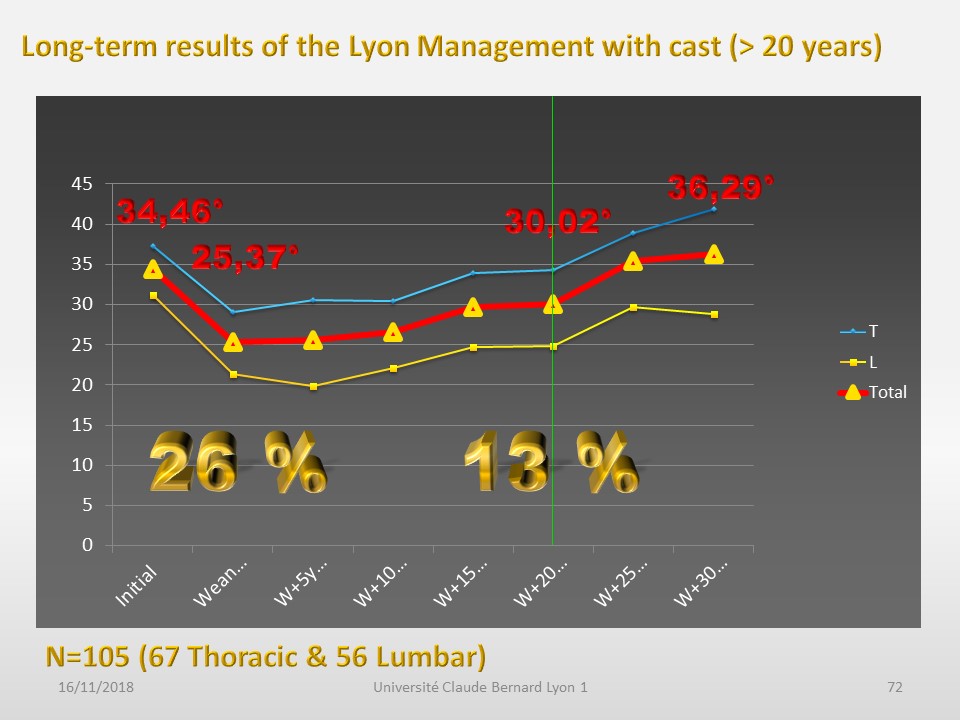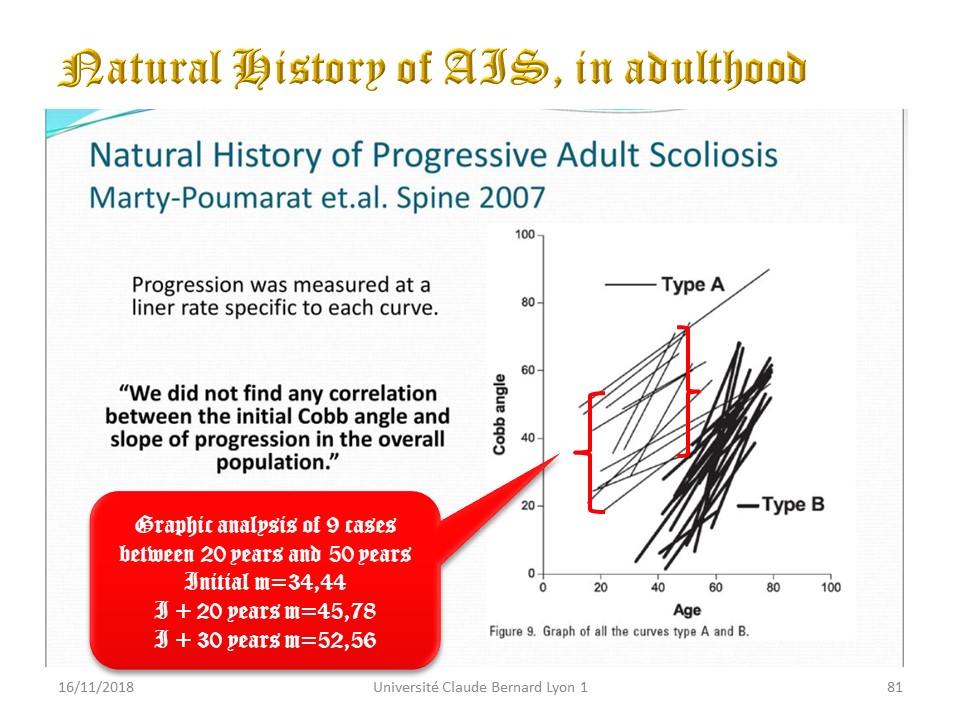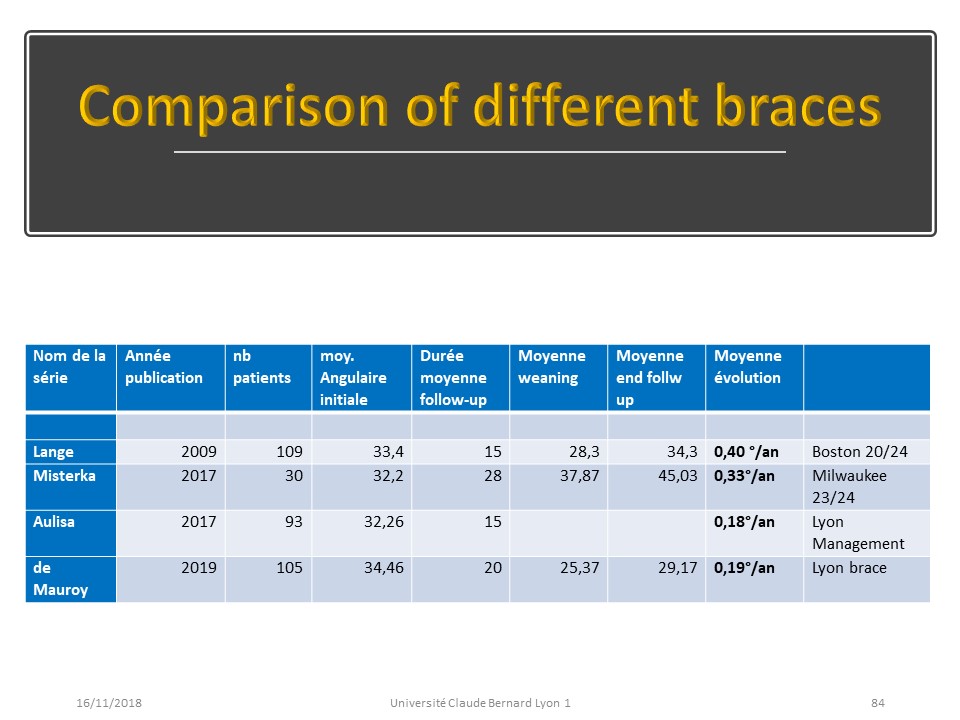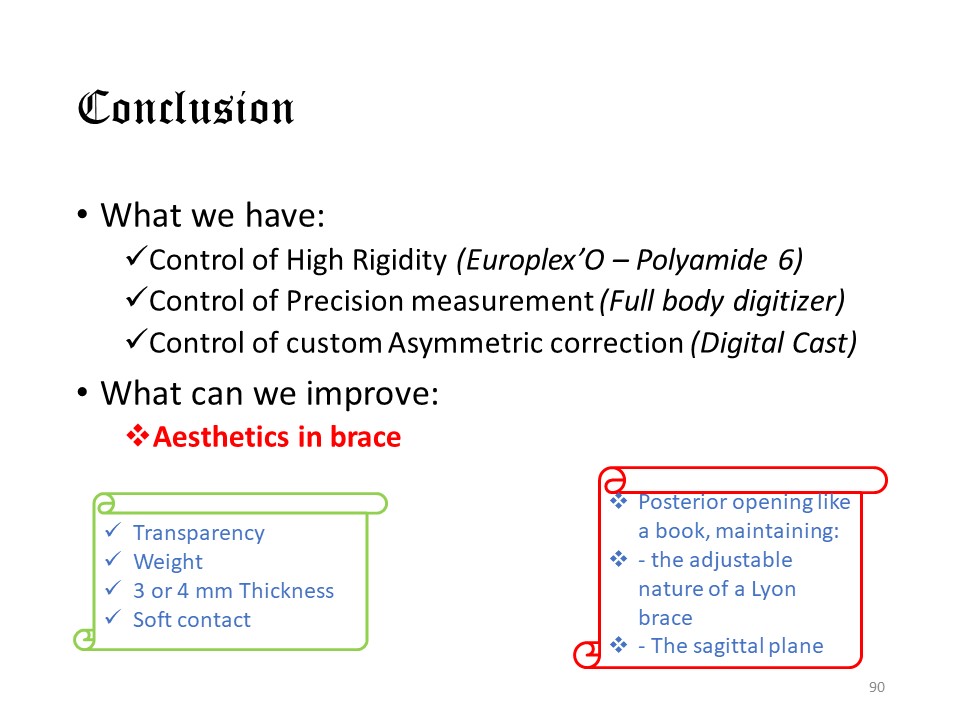 |
|
 |
We know that bracing scoliosis is effective to prevent worsening during growth and sometimes to correct partially the curve. We know the natural history of scoliosis in adulthood. Does scoliosis bracing change the natural history of scoliosis in adulthood?
|
 |
The characteristic of the Lyon Method is the plastic deformation obtained by the initial plaster cast.
|
 |
105 patients were seen between 20 and 30 years after brace weaning. 92 women and 13 men, about the same percentage of 88% as patients treated during adolescence.
|
 |
82 patients were seen 20 years after brace weaning. The initial angulation was 34.46 °. The angulation 20 years after weaning was 29.17 ° is a persistence of the initial angular improvement of 15%.
|
 |
65 patients were seen precisely between 2 and 20 years after brace weaning. The angulation at the end of treatment was 25.37 ° and 20 years after weaning was 28.22 °, ie an annual evolution of 0.14 ° per year.
|
 |
55 patients were seen between 20 and 25 years after brace weaning. The annual progression is slightly higher in the premenopausal period, which is also seen in adult scoliosis with the occurrence of de novo scoliosis at this time.
|
 |
If we fill in the missing data, the mean initial angulation of the 105 patients was 34.46° with an end-of-treatment angulation of 25.37° or 26% angular correction. 20 years after brace weaning, the mean angulation was 30°, which still corresponds to a 13% improvement compared to the initial angulation. Significant angular recurrence was confirmed between 20 and 30 years after weaning.
|
 |
If we consider the average angular progression since the removal of the brace, we find a progression of 0.15°/year for 20 years with a clear increase in slope between 20 and 30 years.
|
 |
There is an excellent correlation between the end of treatment and angulation 20 years later.
|
 |
for both thoracic and lumbar curvatures.
|
 |
It is interesting to compare these results with data from the literature on the natural history of idiopathic scoliosis in adulthood. For Bjerkreim, the average annual progression is 0.5°/year for curves less than 40°.
|
 |
The other authors show a similar increase of 0.5°/year.
|
 |
In 1981, Weinstein published a statistic on 219 patients.
|
 |
With especially a reproduction of the evolution between 20 years and 60 years depending on the type of curvature. The evolution between 20 and 40 years for curvatures of less than 50° at 20 has been isolated.
|
 |
Thoracolumbar and lumbar curvatures have been grouped together.
|
 |
Another work published in 2007, allowed us to add 9 patients.
|
 |
It is thus the group formed by a total of 31 patients with graphs published in the literature and constituting the natural history that we will be able to compare with our patients treated by the Lyon method.
|
 |
We find a natural history of 0.44°/year between 20 and 40 years whereas the evolution of treated patients is only 0.17°/year.
|
 |
Publications concerning the long-term results of braces are rare. Boston and Milwaukee treatments are slightly below natural history. On the other hand, the Italian team from Aulisa, who also used the plaster cast, presents results that are superimposable to ours.
|
 |
This patient had a 45° scoliosis with predominant rotation in the lumbar region.
|
 |
Surgery was indicated.
|
 |
The patient preferred a conservative treatment which limited the evolution to 5° at the thoracic level over 25 years.
|
 |
The cosmetic result is more difficult to appreciate due to weight loss.
|
 |
But the rib hump has clearly diminished.
|
 |
In conclusion, the treatment by the Lyon method with reducing plaster cast gives excellent results which were undoubtedly lost with polyethylene braces without prior plaster cast. Modern technologies allowing to avoid the plaster cast and to improve the angular in-brace correction should make these results even more reliable.
|
 |
|
 |
The new Lyon ARTbrace results from the technological evolution, but especially from the fantastic research work carried out during the last 15 years within the SOSORT. In addition to the technicality of the orthotist, thank the physiotherapist permanently encouraging the child and potentiating the results of the brace.
|
 |

To register for Certification, please contact SSOL

|